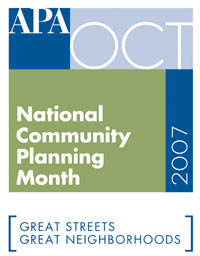I didn't know that October is
National Community Planning Month.

A lot of the time, I am engaged by the possibilities, and turned off by the embrace of mediocrity and small minded thinking that too often typifies planning initiatives, neighborhood meetings, and civic organizations--something that I call the tyranny of neighborhood parochialism.
1. I wrote this (partly redacted) yesterday morning in response to a colleague's query:
What I find very interesting is that people are stunted in their own personal growth and understanding about these issues. What I mean is that people like the XXX were pivotal in the anti-freeway fight and pro-subway development. So you would think that they would want to continue to grow, learn, and work to maintain and extend the qualities that make the city great. Now, instead of fighting freeways, the fight is to attract income tax paying residents in buildings and an urban form that encourages transit, walking and bicycle use instead of cars, in a way that protects historic neighborhoods--that means adding density selectively around transit stations and in commercial districts--which for the most part used to be transit corridors back in the day of the transit city.
Similarly, why doesn't the public expect more from publicly-owned assets such as the Brooks Mansion, which functions as an office building, with limited access.
[...]
I don't know if you are familiar with the old DCOP report: Trans-Formation: Recreating Transit-Oriented Neighborhood Centers in Washington, DC
It's very good. TOD is merely a recasting of the city building principles laid down during the walking and transit city eras. For awhile I have thought that the City needs to take the first 10-15 pages of this report and make them into boards that they can take from meeting to meeting.
Until people understand the foundational/meta principles, we aren't going to see a lot of progress--in XXX or elsewhere in the city. For some time I have maintained that the reason there was support for planning and change on H St. is that there was a consensus that H Street wasn't working for most segments of the area. Even if we didn't agree on what to do, everyone agreed that something needed to be done. Most neighborhoods don't have that base level of consensus.
2. Last month I sent some deep and detailed emails around about the opportunities presented by the unfortunate fire at Eastern Market, and the need to consider broader issues around placemaking and the district around the Market, the Market being foundational, but not the only component.
I thought my writings went over like a lead balloon. There was but one response.
-- Opportunity in adversity -- Eastern Market, DC
-- Opportunity in adversity #2 -- Eastern Market, DC
But I learned last night that things are percolating quite a bit more than I believed possible.
Those little victories keep me going...
Labels: capacity building, civic engagement, land use planning



0 Comments:
Post a Comment
<< Home